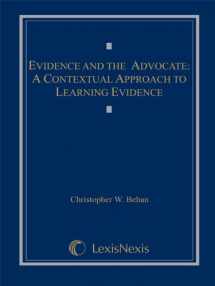
Evidence and the Advocate: A Contextual Approach to Learning Evidence (2012 Loose-Leaf version)
ISBN-13:
9781422490587
ISBN-10:
1422490580
Author:
Christopher W. Behan
Publication date:
2012
Publisher:
LexisNexis
Format:
Ring-bound
738 pages
Category:
Civil Procedure
,
Rules & Procedures
,
Litigation
FREE US shipping
Book details
ISBN-13:
9781422490587
ISBN-10:
1422490580
Author:
Christopher W. Behan
Publication date:
2012
Publisher:
LexisNexis
Format:
Ring-bound
738 pages
Category:
Civil Procedure
,
Rules & Procedures
,
Litigation
Summary
Evidence and the Advocate: A Contextual Approach to Learning Evidence (2012 Loose-Leaf version) (ISBN-13: 9781422490587 and ISBN-10: 1422490580), written by authors
Christopher W. Behan, was published by LexisNexis in 2012.
With an overall rating of 4.0 stars, it's a notable title among other
Civil Procedure
(Rules & Procedures, Litigation) books. You can easily purchase or rent Evidence and the Advocate: A Contextual Approach to Learning Evidence (2012 Loose-Leaf version) (Ring-bound) from BooksRun,
along with many other new and used
Civil Procedure
books
and textbooks.
And, if you're looking to sell your copy, our current buyback offer is $0.44.
Description
Evidence and the Advocate teaches each rule of evidence using a three pronged approach: (1) a treatise-like explanation of the rule, its purposes, exceptions and foundations; (2) cases, discussion questions and hypothetical problems related to the rule; and (3) an application section in which the students must prepare a courtroom exercise putting the rule into action. This approach forms a teaching template for each rule of evidence. Each application exercise stands alone and has been designed to illuminate the rule being taught. The application exercises range from simple form-of-question drills to full-fledged evidentiary hearings. Some require minimal preparation, and others require significant out-of-class research and preparation. In the exercises, students serve as attorneys, witnesses, judges, and, in the more involved exercises, as a court of appeals. The exercises build on each other. The initial exercises focus on fundamental advocacy skills such as conducting a direct examination or laying the foundation for an exhibit. Later exercises incorporate these foundational skills for more complicated tasks such as writing a motion, impeaching a witness, or conducting a Daubert hearing on the reliability of expert testimony.


We would LOVE it if you could help us and other readers by reviewing the book
Book review

Congratulations! We have received your book review.
{user}
{createdAt}
by {truncated_author}


